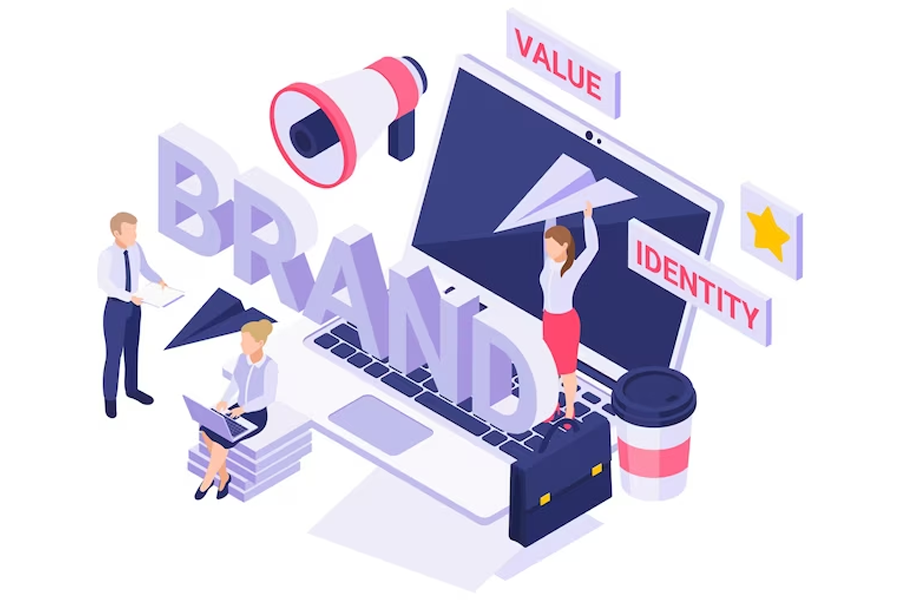What’s the difference between Coke and the thousands of other sodas? You might think it’s the taste, secret ingredients, or million-dollar marketing. And while those are certainly a part of it, the most significant difference is just one thing: branding.
Coca-Cola is a brand that has been established for many years. Even if another product can replicate the taste, the ingredients, or the marketing exactly, if it’s not Coke, then it’s not Coke.
But what if we told you you can do the same for your business?
The elements of branding that this billion-dollar company uses can also be applied to your business, whatever it is. With a strong brand identity, your business will not just be set apart; it will also stand the test of time.
Learn how to perfect your branding elements and create an identity that will last.

What is Branding and Why it Matters in 2024
When you hear “brand,” you’ll likely think about logos, colors, slogans, and all the individual elements.
Branding, as a whole, can take time to pin down. However, as a whole, you can describe a business’ brand as your audience’s overall perception of your business.
It means the individual components, like the visual assets that were mentioned. It also includes your publication voice, your reputation on social media, and the emotions you evoke. Viewed differently, it’s the promise your business makes to your customers.
There are many potential benefits a good branding strategy gives to your business, such as the following.
- Communicates a unique identity: Your branding communicates your unique value through unique brand elements.
- Builds trust and recognition: Consistent branding builds trust and recognition, making your target market choose you over competitors.
- Provides proof of quality: A successful brand communicates quality to its target market. Your customers don’t have to ask, “Is this product good?” They know from your brand.
On the customer side, your brand is how they perceive your business. It’s your identity, your voice, and your promise.
On the business side, your brand development is a long-term strategy for business success. It’s how you want to be known, how you will attract your target audience, and how you will sell products or services that align with your brand values.

The Main Elements of Branding
In today’s market landscape, a cohesive brand identity is critical. In a world saturated with potential choices, customers rely on your brand identity elements and marketing materials to determine whether your offers are for them.
With a strong brand message, you talk directly to a target customer and resonate with them. But if your brand strategy weakens, you’ll just be wasting resources.
Thus, you need to make your digital marketing strategy impeccable. The most important thing is learning the fundamentals: the elements of branding. That’s what this section will discuss.
Visual Elements of Branding
Visual elements are the components of branding that you see. These designs make your business instantly recognizable and distinct from your competitors. Elements include your brand’s logo, colors, typography, visual style, animations, etc.
This brand element is your public face. Customers know a strong brand just from their color palette or the shape of their logo — building a strong and memorable brand identity.
What are the biggest components of your brand’s visual identity?
Here are the most important ones:
- Logo design and typography: The logo design is one of the most important elements of your brand. Your logo is a unique symbol that represents it, while your typography is fonts and styles used in a brand’s communication. Strong brands choose logos and fonts that reflect their brand’s personality.
- Color palette and visual identity: Colors evoke emotions and create a mood, while other image elements, such as patterns or icons, create a distinct personality. Choose colors and graphics that show personality while being consistently usable across all materials.
- Packaging and product design: This component has to do with how your physical or digital products are presented, incorporating all the other components already mentioned in addition to usable design. Product presentation is an important branding element — customers need to feel that the product is coming from you.
- Website and digital design: Your company website is your online face, so it has to be distinctly recognizable. It should incorporate logos, fonts, colors, image elements, and the design of your brand. Additionally, it must also be user-friendly.
For your business, these visual components create a unique personality that your customers quickly identify and connect with. This visual consistency is essential — it makes you stand out in a crowded market, making it easier for people to remember, choose, and trust your brand.

Brand Messaging and Communication
This element is how you talk to the world. It’s what language you use to tell your story, share your values, and connect with your customers. Essentially, what, how, and when you say things and the specific emotions you will evoke.
This isn’t about the font (a visual element) but the message behind it. These are your brand voice, tone, style, and even values. Good brand messaging is clear, consistent, and aligns with the brand’s identity.
Here are the key components of this branding element:
- Brand mission and values: The mission is what the brand intends to do, the “why” behind the business. Values are the principles guiding decisions. These two define your brand’s essence. They hone key messages, shape your identity, and influence consumer perception.
- Brand story and positioning: The brand story narrates the journey, while brand positioning is the unique space a brand occupies in customers’ minds. Successful brands use these components to make a brand unique in their audience’s perspective.
- Brand voice and tone: A recognizable voice creates close familiarity, maintains a consistent personality, and builds relationships. The right tone of voice ensures communication is appropriate and resonates with the audience. They are critical in creating your brand personality.
- Brand messaging across channels: Different marketing channels tend to create variance in messaging. Effective brands place care and effort into maintaining brand communication consistency, whether on a website, social post, or traditional billboard. Consistency reinforces brand identity.
Strong and effective brand messaging for your business stacks up positive perception and eventually builds a mountain of trust. Customers are likely to choose and stick with your brand if you communicate your mission and purpose. However, compelling messaging and storytelling require complex skills, so plan for it accordingly.
Brand Experience and Touchpoints
What do your customers feel when they interact with your brand?
The overall perception of your brand is the brand experience, while the individual interactions that make it happen are the brand touch points. They are both essential branding elements of this day and age, given the many different ways your potential customers meet your brand daily.
All the other brand elements discussed shape your brand experience (for example, your ads contain visual and messaging elements).
There are core elements that shape experience, which you can check below:
- Customer service and support: Good service builds trust and shows that you care. It creates a positive overall experience and even turns a problem into an opportunity to impress.
- In-store experience and ambiance: This refers to the atmosphere and feel a customer experiences when they visit your physical store. A pleasant in-store experience makes customers feel comfortable and welcomed and evokes the emotions you want your brand to be associated with.
- Online user experience and navigation: A user-friendly online experience ensures customers find what they need quickly and easily. It contributes to a positive perception of your brand and encourages online engagement.
- Product and service quality: The actual quality and performance of your offering is a big part of your customer’s overall satisfaction. Consistent quality builds trust, nurtures loyalty, and even gets you recommended. Thus, we should not just meet customer expectations but exceed them.
Each of these components shapes your overall brand experience. Businesses prioritizing a seamless and positive brand experience at every touchpoint are more likely to retain customers, receive positive word-of-mouth, and stand out in a competitive market.
Brand Culture and Internal Branding
Branding is all about perception — not only from the outside but also from the inside. This key element deals with how you and your employees view the company.
Internal branding is the deliberate effort to align your employees with your brand’s mission and vision. It’s the internal design to match office personality traits with the business’ greater ”why.” Brand culture is the shared values, beliefs, and behaviors that define how your team interacts with each other and approaches their work.
There are several components to this, such as the following ones:
- Shared principles: These are the commonalities that guide your team. Values, beliefs, and attitudes create a cohesive work environment, encouraging collaboration and forging a sense of belonging.
- Employee engagement: Do your employees believe in their work? Employee engagement is the level of commitment and enthusiasm that your team has for their work and brand.
- Consistent internal communication: Clear and regular communication about the brand’s values, goals, and expectations within the company sets the tone. It ensures that employees understand the direction. It also builds a sense of purpose and connection.
Everything starts from the inside, so these two branding elements are the foundation for building your winning brand. When employees understand and embody different brand elements and company values, they become brand ambassadors who deliver your message to the world.

Branding Strategy and Implementation
Now that you understand how important branding is, start crafting a strong brand image. But you can only do that once you have a good brand strategy.
If you want a brand that stands out and succeeds to the test of time, you must create excellent brand assets. Important branding elements take time, effort, and resources to produce. Without a solid plan, your branding process might fall apart without solidifying your brand position.
In any branding strategy, these are the key steps that a successful business must plan for:
- Conducting market research: This is when a company researches to understand its target audience, competitors, and industry. Data from this research will inform everything in the future, so researching the local and global markets is necessary.
- Identifying target audience: Your target audience is the specific market group your brand aims to reach. Tailoring your brand to a specific audience increases the chances of connecting with them on a personal level.
- Defining brand purpose and values: This step is when you will define your brand’s guiding principles. Having set and shared principles will determine what the brand stands for, guide its actions, and connect with like-minded customers.
- Develop key elements: Once the foundations are set up, you will create the key brand elements. Here, you will craft a brand name, recognizable image, unique branded vocabulary, start building your brand awareness strategy and all the other important elements that make up your brand.
- Ensure consistency across channels: Customers should know that your brand has the same personality, whether online or offline. This takes planning to redesign websites, paper publications, and even store interiors.
- Implement and monitor your strategy: Good positioning takes targeting. Regular monitoring lets you align with market changes and ensures the brand remains relevant over time. You’ll likely use a good analytics suite for your specific needs.
Your business will likely have unique branding needs, so talking to dedicated professionals or even third parties is recommended. They’ll craft a perfect approach for your business. Nevertheless, these general steps ensure a systematic and effective approach to developing your branding strategy.
Challenges in Maintaining and Evolving Branding
A strong brand offers you many potential benefits. But in such a dynamic and information-saturated market landscape, maintaining and evolving your brand is more complex than ever.
One of the biggest challenges many companies face is how quickly consumer preferences change. With how quickly social and economic trends rise, your entire brand strategy can sometimes seem at odds with months of research seemingly overnight.
Staying attuned to shifting trends, technologies, and societal changes is critical for addressing this. That’s why monitoring should always be a part of your brand strategy.
Budget constraints are also often an issue. This is especially true for small to medium-sized businesses that don’t have the resources to pour into marketing strategies.
But with today’s technology, you can use creativity to combat budget constraints. Business owners can find branding training and suggestions on YouTube and other education platforms, while tools like Canva make it easier and cheaper to make visual branding. Most complex skills, such as video editing and even content generation, are also simplified by AI tools.
Lastly, you might find it overwhelming to start revamping your brand. Good brand management is critical for maintaining your image; you need a good brand strategy. Fortunately, this article discussed the key elements of branding.
Final Thoughts
Branding is the secret sauce that makes your business great. Although your core offerings, systems, and people will be at the core of it, your brand is what people will remember. It’s your identity and, simultaneously, your guiding light.
Thus, take all steps possible to create a strong brand. It’s easier than you think — this article discussed the most important elements and their key components.
With this information, you can sit down with your team, marketing department, or your branding agency of choice. You’re now ready to make the decisions that will make your company stand out and stand against the test of time.
Save this article and use this as a reference for your brand strategy planning!
Frequently Asked Questions
Can my small business benefit from branding?
Effective branding helps you attract potential customers who might otherwise have not thought about your business. When done right, a good brand somewhat equalizes the playing field, helping your business compete with much bigger competitors.
Why is branding important for my business?
Today’s economy is crowded with multitudes of businesses all trying, in one way or another, to sell the same things. A brand is critical, especially when competing against the market. It sets your business apart and clarifies how a brand behaves and what consumers can expect. Brand messaging also holds a company accountable for its mission.
What is a brand strategy?
A strategy is an important element for your branding success. It’s a plan that outlines how you want to be perceived and how you will achieve it. This article discussed everything you need to know about brand strategy, so use it as a reference for success.